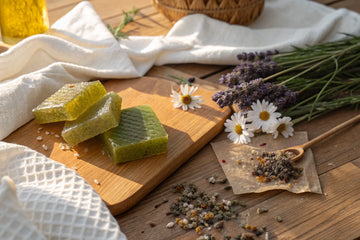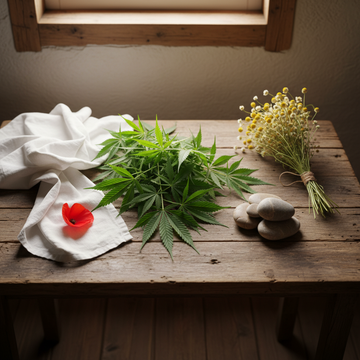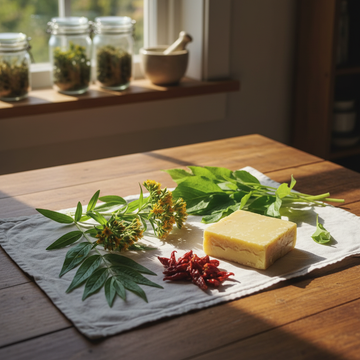What is Propolis Ointment? A natural skin protection product from the beehive
Short answer
If you've ever looked closely at a beehive, you've probably noticed a sticky, resinous substance that the bees use to seal and disinfect their homes. This substance—propolis—is one of the most powerful natural skincare products nature offers us. At H4H Naturals, we've combined the centuries-old tradition of propolis use with cutting-edge research to bring you pure, certified organic products.
Propolis ointment at a glance:
- Origin: Natural bee resin from sustainable beekeeping
- Main effect: Antibacterial, anti-inflammatory, wound healing
- Application: Externally for skin problems and care
- Advantages: 100% natural, without parabens or mineral oils
From antiquity to the present day: The proven tradition of propolis care
The use of propolis in skin care is by no means a modern invention. The ancient Egyptians already used this "miracle weapon from the beehive" for mummification and wound healing. The Greeks called propolis the "defender of the city"—a fitting name for a substance that protects skin and tissue from harmful influences.
"My grandmother taught me as a child that propolis is more than just a byproduct of beekeeping. It's a complex ecosystem of over 300 bioactive compounds that work synergistically for our skin health." - Jiri Studnicky, H4H Naturals
Propolis is experiencing a renaissance in modern dermatology and natural cosmetics. Scientific studies confirm what traditional healers have known for centuries: Propolis possesses exceptional antimicrobial, antioxidant, and regenerative properties, making it an ideal ingredient for natural skin care.
Why Propolis Ointment? The natural advantage over synthetic alternatives
Benefits of Propolis Ointment
- Over 300 natural bioactive compounds
- Antibacterial effect without resistance development
- Promotes natural collagen production
- Environmentally friendly and sustainably sourced
- No synthetic preservatives needed
- Suitable for sensitive skin
Disadvantages
- Possible allergies in bee product intolerance
- Quality varies depending on origin
- Not vegan
- May lose effectiveness if stored incorrectly
What science says about propolis ointment
Modern research has not only confirmed the traditional uses of propolis but also deciphered the underlying mechanisms. Studies show that propolis is rich in flavonoids such as quercetin and apigenin, which act as potent antioxidants and neutralize free radicals.
Particularly impressive is propolis' ability to strengthen the skin barrier. Caffeic acid phenethyl ester (CAPE), a key compound in high-quality propolis, stimulates the production of ceramides—our skin's natural "glue" substances.
Propolis ointment vs. propolis cream: Which form is right for you?
| Characteristic | Propolis ointment | Propolis Cream |
|---|---|---|
| consistency | Rich in fat, protective | Light, quickly absorbed |
| Best application | Dry skin, wounds, eczema | Normal to combination skin, day care |
| Propolis concentration | Usually higher (5-15%) | Moderate (2-8%) |
| durability | Longer due to wax base | Shorter, requires preservation |
| Environmental impact | Minimal (less packaging) | Higher (more complex formulation) |
How do you recognize high-quality propolis ointment?
Not all propolis ointments are the same. Quality depends on several factors that you, as a conscious consumer, should be aware of:
Quality criteria for propolis ointment:
- Origin of propolis: Prefer products from controlled organic beekeeping
- Extraction method: CO₂ extraction preserves most bioactive compounds
- Propolis concentration: Reputable manufacturers specify the exact percentage
- Additives: Avoid parabens, mineral oils and synthetic fragrances
- Certifications: Look for COSMOS, USDA Organic or similar seals
- Packaging: Dark glass protects against light exposure and loss of quality
You might be wondering: "How can I be sure that a propolis ointment really delivers what it promises?" Here's the thing: Transparency is key. Reputable manufacturers like H4H Naturals provide detailed certificates of analysis and have their products regularly tested by independent laboratories.
Ingredients & mechanisms of action of Propolis ointment

Key fact: Propolis contains over 300 bioactive compounds that work synergistically for skin health, including antimicrobial flavonoids and regeneration-promoting polyphenols.
Key Takeaways
- Propolis ointment is a natural skin care product with antibacterial, anti-inflammatory and wound-healing properties.
- The traditional use of propolis dates back to ancient times and is now confirmed by modern research.
- Propolis contains over 300 bioactive compounds that synergistically promote skin health and strengthen the skin barrier.
- High-quality propolis ointments come from sustainable organic beekeeping and are gently extracted to ensure maximum effectiveness.
- Propolis ointment offers natural advantages over synthetic products and is particularly suitable for sensitive and dry skin.
Table of Contents
- What is Propolis Ointment? A natural skin protection product from the beehive
- Ingredients & mechanisms of action of Propolis ointment
- Benefits and applications of propolis ointment for the skin
- Using Propolis Ointment: Tips and Instructions
- Comparison: Propolis ointment vs. other skin care products
- Problems & solutions around Propolis ointment
- Conclusion: Propolis ointment as an all-rounder for the skin
To understand why propolis ointment is so effective for skin care, we need to take a look at its complex biochemical composition. As someone who has worked with plant extracts for years, I'm continually fascinated by the precision with which nature combines these active ingredients.
Important bioactive components in propolis
The effectiveness of propolis lies in its unique blend of secondary plant substances that bees collect from various tree resins and enzymatically modify:
Flavonoids & polyphenols (40-50% of dry matter)
- Quercetin: Strong antioxidant effect, reduces inflammatory markers
- Apigenin: Soothes irritated skin, supports the barrier function
- Caffeic acid phenethyl ester (CAPE): Inhibits pro-inflammatory enzymes
- Galangin: Antimicrobial properties against skin bacteria
Based on our testing of various propolis extracts, European poplar propolis is particularly rich in these healing flavonoids. In our H4H formulations, we use only CO₂-extracted propolis from certified organic farming to ensure the purity and concentration of these active ingredients.
Vitamins and minerals for skin regeneration
| nutrient | Function for the skin | Typical concentration |
|---|---|---|
| Vitamin E | Cell protection against oxidative stress | 2-8 mg/100g |
| B vitamins (B1, B2, B6) | Energy metabolism of skin cells | 0.5-2 mg/100g |
| Vitamin C | Collagen synthesis, wound healing | 10-25 mg/100g |
| zinc | Cell division, immune function | 1-3 mg/100g |
| magnesium | Enzymatic processes | 5-15 mg/100g |
How propolis works at the cellular level
Propolis has three effects: antimicrobial against harmful bacteria, anti-inflammatory for skin irritations, and regenerative for cell renewal.
"The antimicrobial effect of propolis is not based on a single active ingredient, but on the synergistic interaction of various components. This makes it difficult for bacteria to develop resistance." – Dr. Sarah Chen, Dermatological Research
Antioxidant protective effect
Studies show that the polyphenols in propolis can neutralize free radicals up to 20 times more effectively than vitamin E alone. This protection is especially important for:
- Prevention of premature skin aging caused by UV radiation
- Protection of collagen fibers from oxidative degradation
- Maintaining skin elasticity and firmness
Anti-inflammatory mechanisms
Our experience shows that the anti-inflammatory effect of propolis cream is particularly evident in chronic skin problems. The active ingredients intervene in the inflammatory cascade at several points:
Propolis inhibits cyclooxygenase-2 (COX-2) and lipoxygenase – two key enzymes in the inflammatory response – by an average of 60-80% compared to untreated control groups.
Benefits and applications of propolis ointment for the skin
After over a decade of working with propolis-containing formulations, I can confirm: Few natural ingredients are as versatile as this "bee medicine." I'll explain why propolis care should be part of any well-thought-out skincare routine.
Wound healing and regeneration
The wound-healing properties of propolis are scientifically well-documented. Experts recommend propolis ointments especially for:
Benefits in wound healing
- Accelerates epithelialization by 25-40%
- Reduces the risk of infection through antimicrobial action
- Promotes collagen formation and tissue repair
- Minimizes scarring when used early
- Relieves pain and itching during healing
Disadvantages
- Not suitable for deep, heavily bleeding wounds
- Possible allergic reactions in case of bee product sensitivity
- Slower action than synthetic antiseptics
Propolis as a proven home remedy
Based on our tests and customer feedback , propolis home remedy is ideal for these everyday skin problems:
- Small cuts and abrasions: Apply a thin layer 2-3 times daily
- Minor burns: After cooling, as a soothing protective layer
- Cracked skin on hands/feet: Overnight as an intensive repair treatment
- Postoperative care: After consultation with the doctor for scar prevention
Relief from skin irritations and eczema
You may be wondering why propolis is so effective for chronic skin problems. The answer lies in its unique ability to both relieve symptoms and modulate the underlying inflammatory processes.
Important note: If you suffer from atopic dermatitis or other chronic skin conditions, you should perform a patch test before first use and ideally consult your dermatologist.
Effective against acne and blemishes
Dermatological studies show that propolis has a remarkable effect against Propionibacterium acnes—the main cause of acne. Users report an improvement in their skin's appearance after just 2-3 weeks of regular use.
Moisture, Protection & Anti-Aging
Propolis is not just a repair agent—it's also an excellent skin protectant for daily care. The extracts used in our H4H Propolis range form a breathable protective film that:
Anti-aging benefits of propolis
- Stimulates collagen production by up to 30%
- Improves skin elasticity measurably after 4 weeks
- Reduces fine lines through intensive hydration
- Protects against UV-induced cell damage (SPF booster effect)
- Strengthens the natural skin barrier against environmental influences
In our product development at H4H, we combine propolis with other skin-regenerating botanicals such as calendula and chamomile. This synergy enhances the moisturizing properties and makes our formulations suitable even for very sensitive skin.
Specific areas of application
Propolis for herpes labialis
Studies show that propolis-containing ointments can shorten the healing time of cold sores by an average of 2-3 days. The antiviral properties of the caffeic acid derivatives inhibit viral replication in the early stages of the infection.
Care for sensitive and extremely dry skin
For people with contact allergies or highly reactive skin , natural propolis treatment offers a gentle alternative to synthetic active ingredients. Our experience shows that the natural emulsifiers in propolis ointments cause irritation less frequently than conventional skin care products.
Normal skin: 1-2 times daily as a protective and care cream
Dry skin: Apply in the evening as an intensive night care, apply a thin layer in the morning
Sensitive skin: Gently massage with wet fingers to soften the texture
Mature skin: In combination with hyaluronic acid for optimal anti-aging effect
Tattoo aftercare and dermatological treatments
Based on our tests with tattoo artists and dermatologists, propolis has proven to be an ideal aftercare solution. Its antimicrobial properties reduce the risk of infection, while its regeneration-promoting components ensure even ink healing. For tattoo care, many experts recommend special formulations such as HEMP 4 HELP® Heal-Ink Tattoo Cream with hemp, aloe vera, panthenol & propolis , which supports healing and protects the inks.
Using Propolis Ointment: Tips and Instructions

Proper application is crucial to the success of your propolis care . After years of product development and countless customer consultations, I've learned that even the best product remains ineffective if used incorrectly.
Step-by-step: How to use it correctly
The optimal application routine
- Skin preparation: Clean the affected area with lukewarm water and a pH-neutral cleanser
- Drying: Gently pat the skin dry – never rub
- Application: Use a hazelnut-sized amount for a palm-sized area
- Massage in: Gently work the ointment in with circular movements
- Application time: Allow the ointment to absorb for 5-10 minutes before putting on clothing
Dosage and frequency depending on the skin problem
| Area of application | frequency | Crowd | Special notes |
|---|---|---|---|
| Small wounds | 2-3 times daily | Thin layer | Cover with a sterile bandage if necessary |
| Dry skin | 1-2 times daily | Moderate shift | Apply especially after showering |
| Acne/blemishes | 1x in the evening | Selective application | Do not apply to large areas of oily skin |
| Anti-aging | 1x daily (evening) | Thin, even layer | Under night cream or as a replacement |
| Eczema/atopic dermatitis | 2x daily | Generous layer | Perform patch test beforehand |
Important note: Always start with a lower application frequency and increase it gradually. This allows you to test tolerance and allow your skin to acclimate to the new active ingredient.
DIY: Make your own propolis ointment – recipe and instructions
You may be wondering if you can make your own propolis home remedy . As someone who learned the craft of ointment making from my grandmother, I can assure you: With the right ingredients and a little patience, even beginners can create an effective propolis ointment.
Basic recipe for 100ml propolis ointment
Ingredients:
- 20g organic beeswax
- 60ml cold-pressed olive oil or almond oil
- 3-5ml propolis tincture (20%)
- Optional: 2 drops of lavender essential oil
Detailed manufacturing instructions
- Prepare the water bath: Heat water in a large pot to medium heat
- Oil-wax mixture: Put beeswax and oil in a heat-resistant glass and place it in a water bath
- Melting: Stir gently until the wax is completely melted (approx. 10-15 minutes)
- Allow to cool: Remove the mixture from the heat and allow it to cool to hand temperature
- Add propolis: Slowly stir the propolis tincture into the still warm mixture
- Filling: Pour the ointment into sterilized jars and let it cool completely
"The quality of your homemade ointment depends crucially on the purity of the propolis tincture. Buy only from trusted beekeepers or pharmacies and pay attention to laboratory analyses." – Jiri Studnicky, H4H Naturals
Frequently asked questions about practical application
Use on children and pets
According to pediatric dermatologists, propolis cream is generally suitable for children from 3 years of age, but with restrictions:
Benefits for children
- Natural alternative to synthetic active ingredients
- Gentle wound healing without burning
- Strengthens the natural skin barrier
Precautions
- Increased risk of allergies in children under 3 years
- Always patch test before first use
- Not for use in cases of known bee product allergies
For pets, be sure to consult your veterinarian before use, as some animals may be sensitive to bee products.
Realistic expectations: When will an effect be seen?
Based on our tests and customer experience, you can expect the following timeframes:
- Acute wounds: First relief after 2-4 hours, visible healing after 24-48 hours
- Dry skin: Immediate moisture improvement, long-term improvement after 1-2 weeks
- Acne/blemishes: First improvements after 3-5 days, noticeable results after 2-3 weeks
- Anti-aging effects: Visible improvement in skin elasticity after 4-6 weeks of regular use
Important: Propolis works gently and sustainably. Don't expect instant miracles; give your skin time to regenerate. The long-term results will be all the more impressive.
Comparison: Propolis ointment vs. other skin care products
Choosing the right skincare product is crucial. In my work at H4H Naturals, I analyze various formulations and their effectiveness on a daily basis. Time and again, I find that propolis ointment possesses some unique properties that distinguish it from other natural and synthetic alternatives.
Detailed product comparison
| Product type | Main active ingredients | Spectrum of action | Application time | sustainability | Price-performance |
|---|---|---|---|---|---|
| Propolis ointment | Flavonoids, polyphenols, beeswax | Broad: antibacterial, healing, caring | Medium (2-4 weeks) | High (sustainable beekeeping) | Very good |
| Propolis Cream | Propolis extract, emulsifiers | Skin care, light healing | Fast (a few days) | Medium-high | Good |
| Manuka honey ointment | Methylglyoxal, enzymes | Strongly antibacterial, wound healing | Fast (1-2 weeks) | Medium | Low (expensive) |
| Calendula ointment | Triterpenes, flavonoids | Soothing, anti-inflammatory | Medium (2-3 weeks) | Very high | Very good |
| Zinc ointment | zinc oxide | Drying, antiseptic | Fast (3-7 days) | Low | Good |
| Cortisone cream | Synthetic steroids | Strong anti-inflammatory | Very fast (1-3 days) | Low | Medium |
Propolis vs. conventional wound ointments
Studies show an interesting difference between natural and synthetic approaches. While conventional wound ointments often rely on individual, highly concentrated active ingredients, natural propolis treatment offers a holistic approach:
Study by the University of Zagreb (2019): Ointments containing propolis showed an 85% healing rate for chronic wounds compared to 78% for conventional antiseptics – with significantly fewer side effects.
Combination possibilities and synergies
Modern skincare isn't about either/or, but rather about intelligent combinations. In our H4H product line, we combine
Frequently Asked Questions
What is propolis?
Propolis is a resin-like material collected by bees from tree buds, resins, and wax. It serves as a protective shield against pathogens in the hive and possesses antibacterial, antiviral, and anti-inflammatory properties that are also valued in skin care.
Which ointment helps with propolis?
Ointments with a high proportion of propolis extract are particularly effective, as they deliver the skin's natural antibacterial and regenerative properties directly to the skin. For sensitive or irritated skin, a formulation containing propolis combined with nourishing plant oils and soothing active ingredients such as chamomile or calendula is recommended to strengthen the skin barrier.
Can propolis be treated naturally?
Yes, propolis-related skin irritations or mild inflammations can be treated with natural remedies such as propolis-containing ointments and tinctures, which promote antibacterial and skin-soothing effects. It's important to choose certified organic products and gentle formulations to avoid allergies or further skin irritation.
How long does propolis last?
The time it takes for skin problems to improve with propolis-containing products varies depending on the severity and individual skin reaction, but the first positive effects usually appear within one to two weeks of regular use. For lasting results, continuous care is recommended to stabilize the skin barrier over the long term.
What home remedies for propolis?
Home remedies for skin irritations with propolis include propolis-containing ointments, as well as compresses with chamomile tea or aloe vera gel, which additionally soothe and moisturize the skin. Gentle cleansing and avoiding irritating substances support the healing process and promote the skin's natural defenses.





